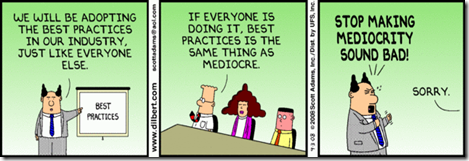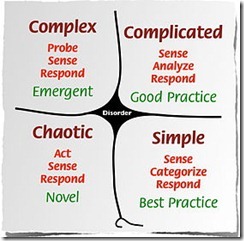 Determinism is the philosophical idea that every event, including every human decision and action, is the inevitable result of preceding actions and that, given certain conditions, there is only one outcome. Nothing else can happen.
Determinism is the philosophical idea that every event, including every human decision and action, is the inevitable result of preceding actions and that, given certain conditions, there is only one outcome. Nothing else can happen.
Deterministic views of the world assume everything is a jigsaw puzzle rather then a chess game and that for every problem there is a single solution.
The logic follows that if this single solution can be identified, then all that’s required is for the series of steps to be described that lead to it and the outcome can be repeated at will.
Although determinism is part of our world, we shouldn’t assume that its principles can be applied everywhere. Anyone who has even the most rudimentary understanding of chess knows that to adopt a strategy based on determinism is to often invite failure.
The ‘Best Practice’ Conundrum
However, it seems that the majority of training and development approaches and processes are based on deterministic models.
“We first need to identify best practice” is a cry often heard in HR and L&D departments as organisations set out on their journey to develop a high performing workforce.
“What’s wrong with that, then?” you may ask.
There’s absolutely nothing wrong with seeing how other organisations achieve their results and trying to learn from them. But do not assume that if you do the same then your results will mirror theirs. That is simply bowing to determinism. Human behaviour and the nature of organisations both tend to be complex and highly variable, and neither lend themself to deterministic approaches.
Best practice is the result of deterministic behaviour and exists only in relatively simple systems.
If a chemical engineer is looking to design a new process or parameters for distillation in a chemical plant she may be able to identify the volumes and sequences that produce the highest amount of pure distillate. Others following an identical process will achieve identical results. This is the positive use of determinism – repeatable processes, identical results.
In more complicated and more complex systems there is no best practice, no single solution that can be transferred from one problem to solve the next without modification.
When we’re dealing with human and organisational learning and performance we’re dealing with highly complicated and complex systems. If we’re to learn from others we should be looking at good practice and novel practices that we can adopt and adapt and massage to work in our own specific context.
The point I am making is that we certainly need to learn from others on a continual basis, but don’t assume that if we find something working well elsewhere all we need to do is to follow the same ‘recipe’ to get the same results.
It’s Not Always Simple
I’d recommend that every HR, Talent and L&D professional make themselves familiar with Dave Snowden’s Cynefin framework if they are looking to better understand the important differences between learning and managing in simple, complicated, complex and chaotic systems. Cynefin is a sense-making model – where patterns emerge from the information and data – that explains how to respond to ordered and disordered systems.
The key point for HR, Talent and L&D professionals is that training is only appropriate in Simple and Complicated systems where cause and effect relationships exist, are discoverable, predictable and repeatable.
In other words, we can design, develop and deliver training to help people address future situations with the confidence that similar actions will produce similar results. Best practice exists only in simple working environments. Good practice (multiple good ways of achieving outcomes) exists in complicated working environments. In complex and chaotic environments (where most knowledge workers reside) traditional training and development approaches that are carried out away from the context of the workplace have little or no impact.
As such, Cynefin questions much of traditional management training and development.
Harold Jarche has been using the Cynefin model for some years to explain the nature of complexity. He offers some good guidance and potential strategies for working and learning in a complex world.
Together with Clark Quinn, Harold has also identified some of the challenges and opportunities created by complexity and how they can be addressed through employing the Coherent Organization Framework to understand and unpick the interrelations between work teams, communities of practice and social networks; define the differences between collaboration and co-operation; and explain how the interaction in the different contexts are synergistic.
Clark’s diagram here gives a clear view.
Jarche recommends coaching, mentoring, linking cognitive surplus with time surplus to solve real problems in the workplace, addressing difficult challenges, and building networks and communities. None of the recommendations include formal training.
This is an approach I have been focusing on for several years and why I have championed the 70:20:10 framework and established the 70:20:10 Forum to help organisations develop their people rather than train them.
Implications for Training
All of the above highlight some fundamental issues around the course/curriculum training model as the principal L&D tool in a complex world.
Where best practice can be defined it seems to make sense that the standard training and development model will work. Where good practice can be defined, training and development may also help by building better analytical capability and judgement. Beyond that, context is critical, complexity abounds and standard training and development approaches fail to have impact.
The issues are highlighted in the areas of management and leadership development. Despite huge budgets and huge amounts of time spent on designing, developing and delivering essentially away-from-work leadership training and development, we still have a situation where the overall quality of leadership is low, employee engagement is generally low and we are not innovating and exploiting our workforce potential nearly as well as we should be doing.
According to a survey undertaken by ORC International, a global customer research, employee engagement and financial services research firm, only 43% of UK workers believe that a positive relationship exists between staff and managers within their organisation. ORC also reports that just under half considered their company to be well-managed.
‘Engage for Success’, a UK Government-supported panel, estimates that the UK’s employee engagement deficit in 2012 to be costing £26bn in productivity each year.
Both of these data points tell us that something is broken.
But they also tell us that there is a great opportunity for improvement by adopting new approaches that will develop our workforce and, particularly, our leaders and managers, more effectively.
Development rather than Training
Mike Myatt identifies some of the important challenges around leadership development in a recent HBR blog article.
Myatt points out that “US businesses spend more than $170 Billion dollars on leadership-based curriculum, with the majority of those dollars being spent on Leadership Training”.
He goes on to say “Here’s the thing – when it comes to leadership, the training industry has been broken for years”.
Myatt touches on the limitations of the deterministic best practice issue in this way:
“When a trainer refers to something as “best practices” you can with great certitude rest assured that’s not the case. Training focuses on best practices, while development focuses on next practices”.
Myatt’s solution, like Jarche’s, is for organisations to create an environment where development occurs through mainly work rather than through training. Myatt goes further and lists the limitations he sees as being offered by the ‘training solution’ and their alternative ‘development-focused’ perspectives.
Examples of the difference between ‘training’ and ‘development’ Myatt provides include:
| 4. Training focuses on the present – Development focuses on the future |
| 5. Training adheres to standards – Development focuses on maximizing potential |
| 6. Training is transactional – Development is transformational |
| 8. Training focuses on the role – Development focuses on the person |
| 10. Training maintains status quo – Development catalyzes innovation |
| 12. Training encourages compliance – Development emphasizes performance |
| 13. Training focuses on efficiency – Development focuses on effectiveness |
| 14. Training focuses on problems - Development focuses on solutions |
You may or may not agree with these binaries. They may represent extremes. However I think Myatt is right. There are changes we need to make:
- We need to address broken training models.
- We need to get better at matching our people-development solutions to specific contexts.
- We need to focus on equipping our workforce for the future, whatever that may hold, rather than trying to ‘fix’ them for the present.
- We need to help our leaders, managers and workers to better exploit the learning opportunities in their daily workflow.
- We need to ensure our HR, Talent, and L&D professionals develop their own skills and capability to help make all this happen.
-------
#itashare


I agree that the Cynefin framework is a really useful one for sense making. It helps people understand that they are trying to deal with a complex issue as if it was complicated. We love to fit things into boxes, increase certainty and have clear pathways. But life often isn't like that!
ReplyDeleteI think the notion of a learning matrix is a useful one for development. While there many be some common elements, it can be personalised for the context and individual. Have you seen any examples of organisations that really put the contextual lens over the development landscape?
Charles, thank you for highlighting L&D’s mistaken obsession with best practice. This may exist within organizations or within parts of organizations but in my experience context is everything. What works in one place has to be examined, understood and – most importantly – interpreted in the light of the destination organization’s context.
ReplyDeleteAbsolutely, Ara! If there were cookie-cutter solutions we could all go home and put our feet up. Unfortunately (or fortunately), there are not.
ReplyDelete